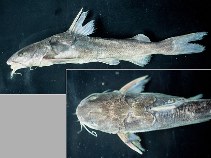| Family: |
Ariidae (Sea catfishes), subfamily: Ariinae |
| Max. size: |
50 cm TL (male/unsexed); max.weight: 33.3 g |
| Environment: |
benthopelagic; freshwater; brackish; marine |
| Distribution: |
South America: Atlantic coastal rivers from Guyana to northeastern Brazil. |
| Diagnosis: |
Dorsal spines (total): 1-1. Three pair of barbels on rostral region, two pairs on lower jaw, one pair on posterior end of maxilla; end of maxilla barbel reaching pectoral fin insertion; large saddle-shaped bony plate with rugosa surface in front of dorsal fin, anterior margin of this plate waved but no deep medial incision; body yellow or gray-yellow dorsally, white ventrally (Ref. 13608). |
| Biology: |
Found in turbid waters over muddy bottoms in shallow coastal areas, also around estuaries (Ref. 3265), and coastal rivers (Ref. 39852). Food items include bottom-living invertebrates. Marketed fresh. Exported frozen (Ref. 5217). Reproduction period is probably between September and November. Egg diameter is 9-11 mm. Males practice mouth brooding of the eggs. (Ref. 35381). |
| IUCN Red List Status: |
Least Concern (LC); Date assessed: 17 August 2011 Ref. (130435)
|
| Threat to humans: |
traumatogenic |
Source and more info: www.fishbase.org. For personal, classroom, and other internal use only. Not for publication.

